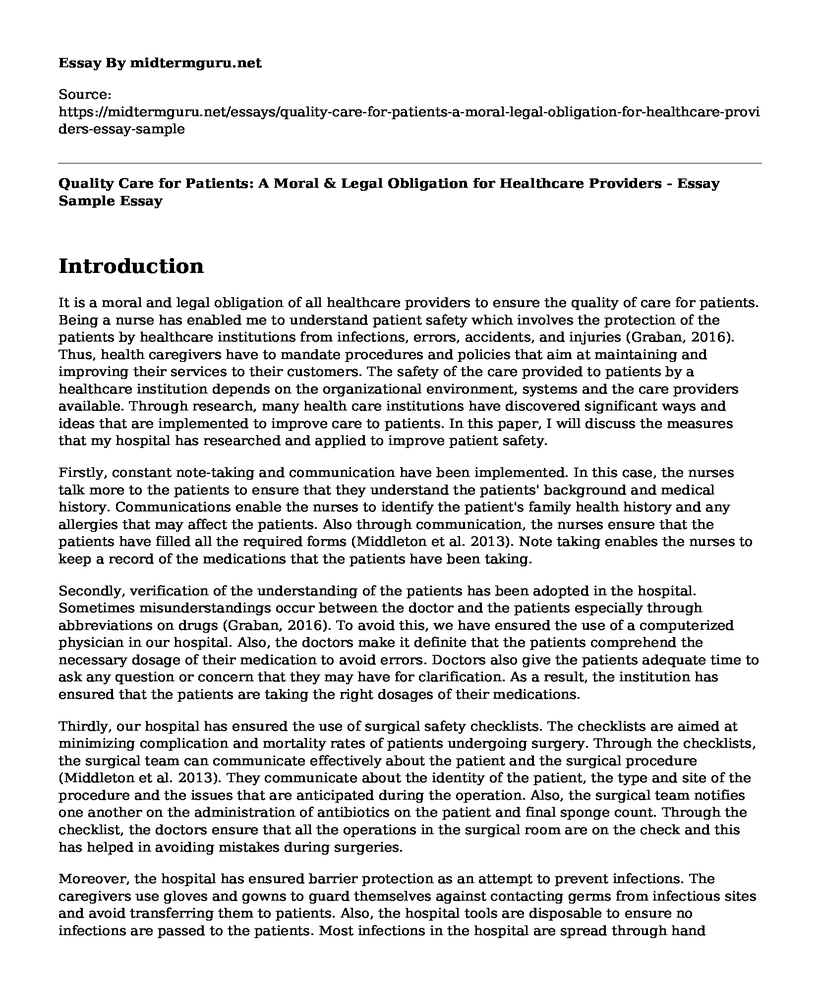Introduction
It is a moral and legal obligation of all healthcare providers to ensure the quality of care for patients. Being a nurse has enabled me to understand patient safety which involves the protection of the patients by healthcare institutions from infections, errors, accidents, and injuries (Graban, 2016). Thus, health caregivers have to mandate procedures and policies that aim at maintaining and improving their services to their customers. The safety of the care provided to patients by a healthcare institution depends on the organizational environment, systems and the care providers available. Through research, many health care institutions have discovered significant ways and ideas that are implemented to improve care to patients. In this paper, I will discuss the measures that my hospital has researched and applied to improve patient safety.
Firstly, constant note-taking and communication have been implemented. In this case, the nurses talk more to the patients to ensure that they understand the patients' background and medical history. Communications enable the nurses to identify the patient's family health history and any allergies that may affect the patients. Also through communication, the nurses ensure that the patients have filled all the required forms (Middleton et al. 2013). Note taking enables the nurses to keep a record of the medications that the patients have been taking.
Secondly, verification of the understanding of the patients has been adopted in the hospital. Sometimes misunderstandings occur between the doctor and the patients especially through abbreviations on drugs (Graban, 2016). To avoid this, we have ensured the use of a computerized physician in our hospital. Also, the doctors make it definite that the patients comprehend the necessary dosage of their medication to avoid errors. Doctors also give the patients adequate time to ask any question or concern that they may have for clarification. As a result, the institution has ensured that the patients are taking the right dosages of their medications.
Thirdly, our hospital has ensured the use of surgical safety checklists. The checklists are aimed at minimizing complication and mortality rates of patients undergoing surgery. Through the checklists, the surgical team can communicate effectively about the patient and the surgical procedure (Middleton et al. 2013). They communicate about the identity of the patient, the type and site of the procedure and the issues that are anticipated during the operation. Also, the surgical team notifies one another on the administration of antibiotics on the patient and final sponge count. Through the checklist, the doctors ensure that all the operations in the surgical room are on the check and this has helped in avoiding mistakes during surgeries.
Moreover, the hospital has ensured barrier protection as an attempt to prevent infections. The caregivers use gloves and gowns to guard themselves against contacting germs from infectious sites and avoid transferring them to patients. Also, the hospital tools are disposable to ensure no infections are passed to the patients. Most infections in the hospital are spread through hand contacts such as touching sensitive parts such as nose, mouth and touching surfaces and food with contaminated hands (Carayon et al., 2014). Therefore, nurses encourage the patients to ensure hand hygiene and go for check-ups regularly to keep them away from infections.
Conclusion
All health care providers have the mandate to ensure that the patient's safety is upheld to avoid infections, injuries, and errors on the patients. The safety of care can be enhanced by carrying out more research and implementing new ideas. In my hospital, patient safety has been improved through the following measures; use of barrier protection, a checklist for operations, enhanced communication and note-taking and verification of patients' understanding.
References
Carayon, P., Wetterneck, T. B., Rivera-Rodriguez, A. J., Hundt, A. S., Hoonakker, P., Holden, R., & Gurses, A. P. (2014). Human factors systems approach to healthcare quality and patient safety. Applied Ergonomics, 45(1), 14-25.
Graban, M. (2016). Lean hospitals: improving quality, patient safety, and employee engagement. Productivity Press.
Middleton, B., Bloomrosen, M., Dente, M. A., Hashmat, B., Koppel, R., Overhage, J. M., ... & Zhang, J. (2013). Enhancing patient safety and quality of care by improving the usability of electronic health record systems: recommendations from AMIA. Journal of the American Medical Informatics Association, 20(e1), e2-e8.
Cite this page
Quality Care for Patients: A Moral & Legal Obligation for Healthcare Providers - Essay Sample. (2023, Jan 01). Retrieved from https://midtermguru.com/essays/quality-care-for-patients-a-moral-legal-obligation-for-healthcare-providers-essay-sample
If you are the original author of this essay and no longer wish to have it published on the midtermguru.com website, please click below to request its removal:
- Essay Example on Holistic Nursing
- Paper Example on American Red Cross Agency
- Sleep Deprivation: Research Paper
- A Comparative Study of Social Media Platforms Used by the Well-Being Sector
- Nutrition Science and Its Benefits: Beyond Weight Management - Essay Sample
- Wellness: An Occupied Incorporation of Physical, Mental & Spiritual Welfare - Essay Sample
- Revolutionizing Diabetes Management: The Power of mHealth - Essay Sample







